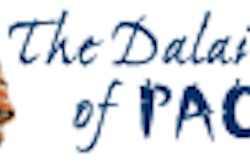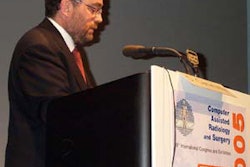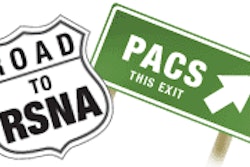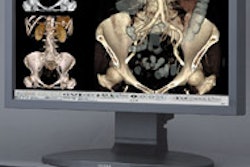Today's radiology environment requires maximum efficiency, and PACS and RIS are tools that can get you there. But maximum value from a PACS investment can be extracted only by transforming the radiology department, according to Dr. Eliot Siegel, chief of imaging at the VA Maryland Healthcare System.
"Success requires basic tools such as PACS and RIS, integration of various enterprise information systems, and re-engineering of workflow processes and personnel to take advantage of the potential that digital imaging and automation can offer," Siegel said.
Siegel shared 10 tips for transforming the radiology department during a talk at an Eastman Kodak Health Group seminar held in New York City last week.
First, Siegel suggests beginning by analyzing your current department, evaluating space, personnel, and equipment. Creating a workflow diagram is also helpful.
"We did a very detailed workflow analysis when we were using film back in the 1980s, and we found that it required 59 steps just to do an inpatient chest radiograph in a paper-based system," he said.
It's also critical to pick the right partner/vendor and the right PACS/RIS network, Siegel said.
"The process is very much like a marriage, given the very, very close working relationship between yourself and your PACS vendor, and also your RIS vendor," he said. "An increasing percentage of sites are now on their second PACS, and an increasing number of sites actually have more than one PACS system, particularly academic sites."
A lot can be learned from those who have been through a PACS divorce, including lessons such as less reliance on a request for proposal (RFP) process for purchase, examining alternative financing approaches, and looking more at software-only models, Siegel said.
Next, hire a PACS administrator and rethink your current personnel, he said.
"A good PACS administrator, or multiple administrators depending on the size of your operation, is an absolute key to the success of the system," Siegel said. "And it's also critical to re-engineer department personnel in addition to workflow."
Integration of information systems is also paramount. The relatively few studies of PACS productivity and cost-savings have shown mixed results. Siegel attributes this to a wide variability in the degree of integration and re-engineering of the department associated with the PACS.
For example, of the 59 steps required at the Baltimore VA Medical Center (VAMC) for an inpatient chest radiograph during film-based operation, only 12 steps were eliminated simply by converting to a PACS and filmless model. Integration, however, helped slice those steps down to eight or nine steps; the result was dramatic changes in the institution's workflow and bottom line, Siegel said.
The vast majority of these steps were eliminated by automated systems that take advantage of the communication among imaging modalities, PACS, and hospital and radiology information systems, he said. The Integrating the Healthcare Enterprise (IHE) initiative has created integration profiles to facilitate this integration using standards such as DICOM and HL7.
Siegel also suggests creating tools to continuously model workflow, making radiology more like an assembly line. Industrial tools that could be applied for radiology workflow analysis include simulation models, an administrative dashboard, and workstation auditing tools.
Continuous monitoring of workflow processes should be performed; workflow optimization does not end with implementation of change, Siegel said.
"If not monitored, workflow process tend to regress to the mean, and end up getting more slow," he said. "So you need to constantly monitor workflow processes."
Siegel advocates creating a digital dashboard concept, in which applications show the status of department information such as throughput and utilization.
"PACS vendors have all of this information as do the RIS vendors," he said. "Being able to display it in a graphical, helpful way for an administrator, I think, is really essential. I think in the next few years you're going to be seeing really interesting solutions for this dashboard."
Auditing tools can allow for automated data extraction and data mining, and can document the actual interpretation process. This allows for assessment of variability of interpretation, Siegel said.
Redesigning workflow for the department can produce measurable gains, he noted. For example, at the VAMC, radiology reading times were about 15% faster with soft-copy reading for CT studies (likely even much faster now following adoption of multidetector CT scanners), and 8% faster for reading musculoskeletal and portable computed radiography (CR) studies, Siegel said.
Radiologists' overall productivity increased more than 50% with PACS, and CT technologists were able to reduce their workflow from 11 steps for film to five for PACS, he said.
"Workflow optimization resulted in reduction of exam time by 45% for a CT study compared with a film-based model," Siegel said.
The institution has also realized a 40% increase in technologist productivity throughout the department.
The importance and challenges associated with training are often underestimated, Siegel said. Noting that nobody reads the manual anymore, it's important to have computer-based training, or at the very least, context-sensitive help, he said.
"PACS vendors are getting better at this online training, but I think there's still a significant way to go," he added.
Also, remake or redo the reading room and other environments, taking into account conditions such as ambient light and ergonomics, Siegel advised.
Rethinking and re-engineering current radiology communication models are important as well, Siegel said.
"I personally think this is the biggest clinical crisis that we have today," he said.
The American College of Radiology's guidelines for communication recommend direct calls by the radiologist in addition to the report to communicate unexpected or urgent results to the referring physician. Reinventing the communication process using tools such as electronic tracking of information can help to close the communication loop, Siegel said.
"I think you're going to see more and more systems that allow you to do that in the next year," he said.
Finally, Siegel suggested transforming the radiology interpretation process.
"Workstations should allow us to be able to support being able to read images any way that we want," he said. "It used to be that we had to read (CT studies) in the axial plane, at relatively thick sections. Now, with 3D capability, what we're doing at the VA and also the University of Maryland is we're doing all of our CT primary interpretations on workstations that allow us to pick our own slice thickness and pick whichever plane we'd read in, or read in 3D mode."
By Erik L. Ridley
AuntMinnie.com staff writer
August 29, 2005
Related Reading
Diagnostic Imaging's future: Bigger than radiology, August 9, 2005
Web-based applications ease PACS, EMR integration, August 4, 2005
3D navigation holds promise for image overload, July 11, 2005
Diagnostic imaging and clinical information systems: An integration primer, April 14, 2005
EMR implementation benefits from prior workflow analysis, February 18, 2005
Copyright © 2005 AuntMinnie.com



















